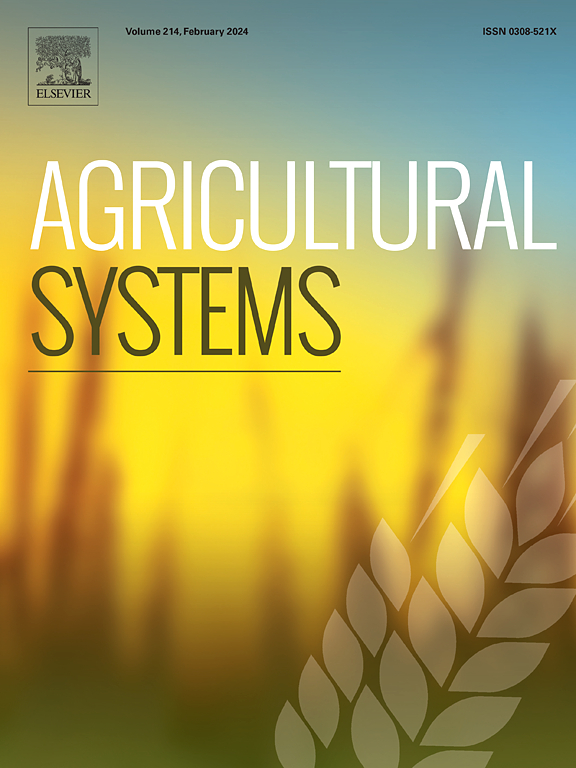全球肉牛生产者全要素生产率和甲烷效率评估
IF 6.1
1区 农林科学
Q1 AGRICULTURE, MULTIDISCIPLINARY
引用次数: 0
摘要
为与强调负责任消费和生产的可持续发展目标12保持一致,全球肉牛产业必须参与可持续生产。未来牛肉生产面临的重大挑战之一是动物饲料和人类食品之间对资源的竞争日益激烈。此外,鉴于肉牛生产是甲烷气体排放的主要来源,迫切需要解决气候变化的影响。目的采用全要素生产率评价方法对2011 - 2020年20个主要牛肉生产国肉牛产量进行评价。2)估算技术效率和甲烷效率。3)估算资源利用和甲烷排放的潜在减少量。4)研究全要素生产率与甲烷效率的关系。方法采用马尔姆奎斯特生产率指数和不期望产出数据包络分析进行评价。本研究将牛的数量、永久牧场和劳动生产率作为投入,牛肉产量和甲烷排放分别作为理想产出和不理想产出。结果与结论结果表明,这20个国家的生产率年增长率为1.3%,主要归功于技术进步。技术效率和甲烷效率得分分别为0.645和0.476。总体而言,肉牛、牧场面积和甲烷排放量的潜在减少量分别为283,257,995头、933,802,815公顷和13414,544吨。全要素生产率与甲烷效率呈正相关。此外,研究结果显示,美国和印度在肉牛生产中表现出相对较高的生产率增长和完全的甲烷效率。因此,美国可以为其他国家实施以牧场为基础的系统提供有价值的参考,而印度的方法对于采用小农为基础的系统的国家来说尤其有见地。意义本研究解决了肉牛生产中甲烷排放的紧迫环境问题。鉴于肉牛生产是甲烷气体排放的主要来源,在考虑不受欢迎的甲烷排放量的同时,估算肉牛生产的甲烷效率至关重要。这项研究有望丰富现有的关于提高牛肉生产可持续性的文献,并提高集体对减少温室气体排放,特别是甲烷排放的认识。最终,它将促进利益相关者之间的合作和协同作用,以实现可持续的牛肉生产。本文章由计算机程序翻译,如有差异,请以英文原文为准。

Assessment of total factor productivity and methane efficiency of beef cattle producers worldwide
CONTEXT
To align with SDG 12, emphasizing responsible consumption and production, it has become imperative for the global beef cattle industry to engage in sustainable production. One of the substantial challenges for future beef production is the increasing competition for resources between animal feed and human food. Moreover, there is a pressing need to address the impact of climate change, given that beef cattle production is a major contributor to methane gas emissions.
OBJECTIVE
To evaluate beef cattle production across 20 major-beef producing countries from 2011 to 2020 by 1) Assessing total factor productivity. 2) Estimating both technical efficiency and methane efficiency. 3) Estimating potential reduction of resource uses and methane emission. 4) Investigating the relationship between total factor productivity and methane efficiency.
METHODS
The assessment utilizes the Malmquist productivity index and data envelopment analysis with an undesirable output. This study considers cattle population, permanent pasture, and labor productivity as inputs, with beef production and methane emissions as desirable and undesirable outputs, respectively.
RESULTS AND CONCLUSION
The results indicate that the annual productivity growth for these 20 countries is 1.3 %, primarily attributed to technological advancements. The technical and methane efficiency scores stand at 0.645 and 0.476, respectively. Overall, the potential reduction in beef cattle, pasture area, and methane emissions are 283,257,995 heads, 933,802,815 ha, and 13,414,544 tons, respectively. There is a positive relationship between total factor productivity and methane efficiency. Moreover, the findings reveal that the US and India demonstrated relatively higher productivity growth and full methane efficiency in their beef cattle production. Accordingly, the US could serve as valuable references for other countries implementing pasture-based systems, while India's approach can be particularly insightful for countries employing smallholder farmer-based systems.
SIGNIFICANCE
This study addresses a pressing environmental concern of methane emissions from beef cattle production. Given that beef cattle production is a major contributor to methane gas emissions, estimating methane efficiency of beef cattle production while considering the undesirable output of methane is critical. This study is expected to enrich the existing literature on improving sustainability in beef production and raise collective awareness about reducing greenhouse gas emissions, particularly methane. Ultimately, it will foster collaboration and synergy among stakeholders to achieve sustainable beef production.
求助全文
通过发布文献求助,成功后即可免费获取论文全文。
去求助
来源期刊

Agricultural Systems
农林科学-农业综合
CiteScore
13.30
自引率
7.60%
发文量
174
审稿时长
30 days
期刊介绍:
Agricultural Systems is an international journal that deals with interactions - among the components of agricultural systems, among hierarchical levels of agricultural systems, between agricultural and other land use systems, and between agricultural systems and their natural, social and economic environments.
The scope includes the development and application of systems analysis methodologies in the following areas:
Systems approaches in the sustainable intensification of agriculture; pathways for sustainable intensification; crop-livestock integration; farm-level resource allocation; quantification of benefits and trade-offs at farm to landscape levels; integrative, participatory and dynamic modelling approaches for qualitative and quantitative assessments of agricultural systems and decision making;
The interactions between agricultural and non-agricultural landscapes; the multiple services of agricultural systems; food security and the environment;
Global change and adaptation science; transformational adaptations as driven by changes in climate, policy, values and attitudes influencing the design of farming systems;
Development and application of farming systems design tools and methods for impact, scenario and case study analysis; managing the complexities of dynamic agricultural systems; innovation systems and multi stakeholder arrangements that support or promote change and (or) inform policy decisions.
 求助内容:
求助内容: 应助结果提醒方式:
应助结果提醒方式:


